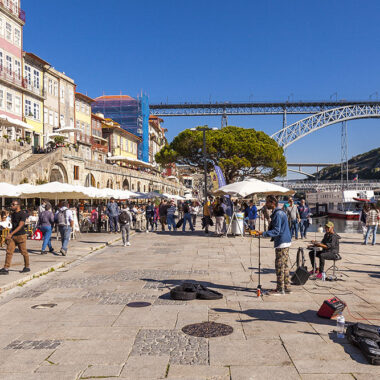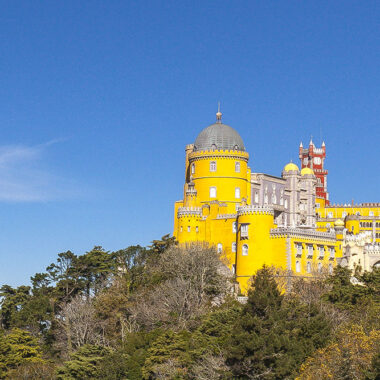The drive from Nazaré to the Douro Valley was just over three hours and Coimbra – a beautiful city some describe as an Oxford type town – worked out to be a great place to stop to stretch our legs and grab a bite to eat. We drove to the top of town to meander through the the university buildings and the Royal Palace, as well as to take in the beautiful views of the city. In old town we stumbled upon a bakery which served not only as a morning tea stop of the delicious natas, but ended up being lunch for the day as well.
We made the decision to stay in the westernmost part of the Douro Valley as it was midway between Porto and the wineries which I was interested in visiting. The accommodation Sam found was superb: a recently converted old school house set amongst the vineyards, high up on a hill with stunning vistas. The kids were out of the car and running around exploring before we’d even parked! They were thrilled to be in a beautiful country setting again. Sam and I enjoyed the fresh air and breathtaking visits as well, deciding to walk up the steep hill to Quinta do Côtto to see if there was an opportunity to taste. Much to our surprise, the super-friendly and gracious winemaker, João, offered for us to hop in his truck for a tour of the vineyards. It turned out that João worked at Chalk Hill Winery in Sonoma County during the 2013 vintage and also in Clare Valley in South Australia in the same year. What a small world it can be! The tour was incredible and so unexpected: he explained the wines, vineyards, and history of Quinta do Côtto as well as providing a better understanding of the broader Douro Valley. We also toured the cellar and tasted many of his 2021 vintage wines still in tank. So fun to experience João’s excitement and enthusiasm for the wines he’s creating. Not only was João a wealth of information regarding Quinta do Côtto but he also provided us with many helpful pointers and delicious places to eat for the remainder our stay in Portugal. Amazing what a little stroll up the hill turned into.
The Douro Valley was created in 1756 and is the oldest demarcated wine region in the world, not to mention a UNESCO World Heritage Site. I thought I’d worked with steep terraces, but the terraces, row directions, slopes and size of the Douro was just mind boggling and so beautiful! I lost count of the number of times I said, “wow!” out loud as we drove the winding steep roads. The Douro River flows through the center of the region from Spain to the Atlantic Ocean and has been vital for transporting the wine via boats called barcos rabelos to Porto over the centuries. Once the wine reached Porto, it would be aged in large barrels called “pipas” in the port cellars along the river in Vila Nova de Gaia. With baking hot summers and severe winters, the port aging cellars were located in the more temperate zones of Porto. The Douro Valley is divided into three sub regions: the Baixo Corgo, Cima Corgo and Douro Superior. The soils are very rocky consisting mostly of schist and the water table is so low that roots must travel 10 meters to find water, no irrigation on the steep hills. There are 40 different grape varieties permitted but the main six for making port are: Touriga Francesa, Touriga Nacional, Tinta Roriz, Tinta Barroca, Tinto Cão, Tinta Amarela. What I didn’t realize before visiting was how many different types of port are made and how heavily regulated and graded both the wines and vineyards are. The ports are either aged in large oak vats (tanks), large barrels (pipas), bottles or in a combination of vessels from two years up to many decades. The various types include Late Bottled Vintage, Reserve, Aged Tawnies, Tawny, Ruby and White Port. The other detail I learned was the involvement of the British in the port industry, a presence that’s been steadfast since the 17th century when Britain boycotted French wine during the wars with France. As the stories are told, in order to help protect the Portuguese wine’s long journey to England, the wines were fortified with grape brandy at the docks prior to travel. The British took a liking to the sweeter, fully tannic and ripe wines and began to invest back into Portugal. There are still a number of port houses and quintas (farms) owned today by the British.





























A friend and colleague of mine, Kristina, worked the 2010 vintage in the Douro Valley and had some helpful suggestions of wineries to visit. She worked at Neipoort so that was first on my list. It was difficult to get in contact with anyone at Neipoort but eventually I spoke with Susana who was just fantastic! She invited me to join a Dutch couple she was hosting at the port cellars in Vila Nova de Gaia (Porto). Susana was so informative, enthusiastic and fun. She knew so much about the history of Neipoort, a family operated company since 1842 when Franciscus Marius Niepoort founded the company. Now being run by the fifth generation Eduard Dirk Niepoort, who grew the business when he acquired property in the Douro and has expanded production by making still wine in a few different growing regions in Portugal.Dirk even had a side project growing and drying tea! Susana was excellent at explaining the different types of port and their aging process. She toured us into a room where special glass jugs ranging from nine-11 liters were being aged, referred to as “garrafeira Niepoort.” Some of them dated back to the 1970s. Talk about a labor of love hand filling and bottling out of each of those garrafeiras. Susana treated us to a delicious tasting of eight different ports, the Colheita 1997 being the stand out for me. So polished, round, full and bright with a delicious nutty and creamy finish. I couldn’t walk out without purchasing a bottle especially given it was from the year I graduated high school. Such an amazing introduction to the Douro Valley that gave me a much broader appreciation for port.






Maçanita was another winery Kristina recommended, the route to which required us to brave the narrow and winding steep roads of the Douro out of Pinhão. The remote and super cute winery was run by a brother/sister team, the two of them crafting some very intriguing still wines from traditional Portuguese varieties. A very friendly and talkative intern hosted us with a tour of the winery and tasting. One of the grading systems in Portugal involves a letter grade determining the quality of a given port vineyard, the letter is “earned” by racking up points from of a list of specific attributes. Maçanita created two still wines: Letra F, which would be a lower graded port vineyard, and Letra A, which would be a high grade port vineyard. I preferred the Letra F, much lighter and brighter in style which was no surprise since the goal of port wine is richer in tannins and density. So much fun to feel the energy of a small cellar getting wrapped up from harvest.










For the last tour and tasting we ventured to Quinta do Panascal, a Fonseca (British-owned) property that incorporated an audio vineyard and winery tour into their tasting. Since 1815, four different families have contributed to the success of Fonseca, the Yeatmans and their descendants have more recently led the brand to prominence during the 20th century and pioneered organic and sustainable viticulture. The 1840 Vintage Port marked the start of great vintages produced by Fonseca with the 1927, 1948, 1977, and 1994 all being awarded 100 points!
The passion behind farming the crazy steep hillsides, foot-stomping port grapes (still to this day), aging in older oak vessels, and patiently waiting for the prime amount of bottle age was impressive. One can only hope that future generations will continue the tradition of crafting wine in one of the most amazing and challenging regions in the world.






























































Pingback: Porto - Our Walkabout Two
A great blog, summarizing your tour of the wine region. Having personal guides with worldwide connections and stunning weather, providing for beautiful photographic memories which certainly jogged my memory bank of touring the region.